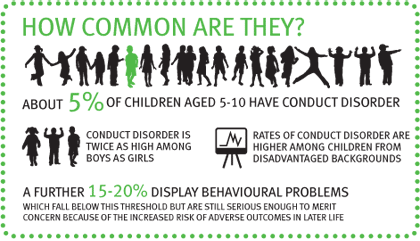
CONDUCT DISORDER
Children and adolescents with Conduct Disorder exhibit emotional and behavioral problems. These kids and teens often act in socially unacceptable and often illegal ways. These behaviors are exhibited at home, school and in most social situations. Although their actions are wrong, they often feel no remorse or empathy for their actions (Mental Health America 2013). Conduct Disorder is usually diagnosed before the age of 16, but can go undiagnosed because children with Conduct Disorder are often stereotyped as "bad boys" or "bad girls" and therefore are only punished often instead of being provided the help they need. Conduct Disorder causes significant impairment in their day to day social functioning (PsychCentral).
Definition
Instructional Strategies
Students with Conduct Disorder like power struggles. They will often challenge class rules, refuse to do their work, and argue with or pick on other students. These students do not do well with phrases like "You need to do..." because they do not like being ordered around. It is easiest to work with these students in a high staff/student ratio. Meaning having an assistant teacher or a student aid will help to keep the students behavior appropriate and their outbursts to a minimum (Difficult Students 2015). Some things to be aware of when teaching a student with Conduct Disorder
-
Since social interaction can lead to behavioral outbursts, try having the student complete some work on a tablet or laptop if those resources are available. Use this sparingly, as you do not want the student to become dependent on or expect to be able to use the laptop for his/her work. The student still needs to learn how to appropriately interact with their peers and teachers.
-
Make sure classroom rules are clear, displayed somewhere in the room, and consistently enforced to not only the student with Conduct Disorder but to ALL students.
-
When doing class work, give the student the option of either working alone or working with a small group of his or her classmates. This allows the student to base their work method on the way they are feeling that day. If they are not having the best day, working alone, or one on one with their teacher or aid may be the best method for them. If its a good day working in a small group may be a good way to increase their social skills. Another option is allowing the student to pick one person in class he or she is comfortable around when doing group work and making sure they are in a group together.
For more instructional strategies and tips click here, or here
Useful Websites
For Parents:
Is your child showing signs of conduct disorder?
Risk factors, co-occurring disorders, and next steps...
Feeling lost? confused? Alone?
"A soft place to land for weary parents"
**a forum for parents to join together and gain knowledge,
get advice, or just share their story.**
For Teachers:
Planning, Instruction, Students social and emotional well being
IEP Information regarding Conduct Disorder
Indicators, Accommodations/Interventions, Other Resources*
**written by an actual teacher 'Brandon U' and his blog of teacher tools**
Research
I.) Strategical research towards a foundation for the diagnosis of conduct disorder in the DSM-V (Diagnostic and Statistical Manual of Mental Disorders)
-Issue I -- Child onset vs. adolescent onset Conduct Disorder
- Definition
- Childhood limited subtype
- Reliability
-Issue II -- Family Psychiatric History as an aid to diagnosing CD
- Definition
- Rationale
- Disadvantages
-Issue IV -- Neuro-imaging bio-markers for CD
- Definition
- Reliability
- Disadvantages
-Issue V -- Genotypes as bio-markers for CD
- Definition
- Research that is still needed
II.) Conduct Disorder in children and adolescents
- Summary
- Diagnostic Criteria
- Association with other mental disorders
- Genetic determinant
- Measures to prevent conduct disorder
Other
Children who have conduct disorder often develop Antisocial Personality Disorder as they progress into adulthood.
Definition: a mental health condition in which an adult has a long term pattern of manipulating, exploiting or violating the rights of others, often in a criminal manner
Causes: it is believed that conduct disorder in children is linked to adults with Antisocial Personality Disorder however, other causes are unknown. Some say psychopathy is another term for this disorder; while others disagree and say psychopathic personality disorder is a more severe form of Antisocial Personality Disorder.
Symptoms: A person with antisocial personality disorder acts charming and sweet but are using these skills to manipulate peoples emotions. They...
- repeatedly break the law
- disregard the safety and well being of others
- often have issues with substance abuse
- show no guilt or remorse
Treatment: Psychotherapy is the main treatment for Antisocial Personality Disorder. This uses Cognitive Therapy and Behavioral Therapy to change the way a person thinks and acts. Medicine is not directly used to treat Antisocial Personality Disorders, however; anti-psychotics are often used to stabilize mood swings and violet outbreaks.
For more information on Antisocial personality disorder click here





Sources
- “Antisocial Personality Disorder.” Psychology Today, Sussex Publishers, 19 Apr. 2017, www.psychologytoday.com/conditions/antisocial-personality-disorder.
- Balance, Brain. “Signs and Symptoms of Conduct Disorder.” Brain Balance Achievement Centers Parent Blog, 2017, blog.brainbalance.com/blog/2015/04/signs-and-symptoms-of-conduct-disorder.
- “Conduct Disorder (CD).” Conduct Disorder (CD) , www.teachspeced.ca/conduct-disorder.
- “Helping Your Adolescent with Conduct Disorder.” Evolve Treatment Centers, 2017, evolvetreatment.com/for parents/parent-guides/conduct-disorder/.
- MHA. “Conduct Disorder.” Conduct Disorder , Mental Health America , 14 Oct. 2013, www.mentalhealthamerica.net/conditions/conduct-disorder.
- “Strategies for Learning and Teaching.” Special Education Support Service, SPSS, www.sess.ie/categories/emotional-disturbance-andor-behavioural-problems/conduct disorder/tips-learning-and-teach.
- Bressert, Steve. “Conduct Disorder Symptoms.” Conduct Disorder Symptoms, Psych Central , 13 Aug. 2017, psychcentral.com/disorders/conduct-disorder-symptoms/.